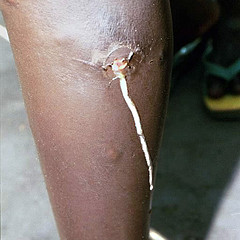
To expand upon Mrs. Lythcott’s mention of the guinea worm: the guinea worm disease ( dracunculiasis) is rapidly heading towards eradication. As of July 13, 2009 only 845 cases of guinea worm disease have been reported this year. This is a considerable decrease considering 5,000 cases were reported in 2008. In 1986,when the guinea worm eradication program began under the Carter Center 3.5million people in 20 countries were suffering from this disease. Currently the disease is only common in Sudan, Ghana, Mali, Ethiopia, Nigeria and Niger.
The eradication program has focused on health education as well as filtering water supplies. The disease is caused by fleas in stagnant water that leave larvae inside in the human body which eventually grow up to three feet long. The resulting worm then forms a blister in the skin and begins to exit the body leaving their hosts incapacitated for up to a month. A simple cloth filter is sufficient to interrupt the life cycle of the guinea worm. Therefore, this eradication program is particularly different from that of smallpox because it does not include any use of medicines or vaccines.
The certification of the eradication of this disease will certainly take some time because the disease has a 1-year incubation period. (The certification period for smallpox was two years when the incubation period was only about 12 days). Nevertheless, this program is certainly showing promising results and it appears that there will soon be a new disease to keep smallpox company on the eradication list.
With guinea worm disease as an example, the key to future eradication efforts may lie outside of the realms of the medicines and vaccines. Therefore, true eradication may actually be possible for diseases such as malaria and yellow fever in the future.
No comments:
Post a Comment